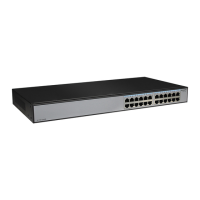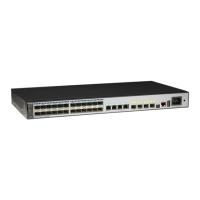such as Hello packets, DD packets, LSR packets, LSU packets, and LSAck packet, are
transmitted in unicast mode.
l Point-to-Multipoint (P2MP): A P2MP network must be forcibly changed from other
network types. In this type of networks, Hello packets are transmitted in multicast mode
(224.0.0.5); DD packets, LSR packets, LSU packets, and LSAck packets are transmitted
in unicast mode.
l Point-to-Point (P2P): If the link layer protocol is PPP, HDLC, or LAPB, OSPF defaults the
network type to P2P. In this type of networks, protocol packets, such as Hello packets, DD
packets, LSR packets, LSU packets, and LSAck packets, are transmitted in multicast mode
(224.0.0.5).
4.2 OSPF Features Supported by the S6700
The S6700 supports various OSPF features, including multi-process, authentication, hot standby,
Smart-discover, TE, DS-TE, VPN multi-instance, BFD, and GTSM.
Multi-process
OSPF supports multi-process. More than one OSPF process can run on the same switch because
processes are mutually independent. Route interaction between different OSPF processes is
similar to the interaction between different routing protocols.
An interface of a switch belongs to only a certain OSPF process.
A typical application of OSPF multi-process is to run OSPF between PEs and CEs in the VPN
where OSPF is also adopted in the backbone network. On the PEs, the two OSPF processes are
independent of each other.
Authentication
OSPF supports packet authentication. Only the OSPF packets that pass the authentication can
be received. If the packets fail to pass the authentication, the neighbor relationship cannot be
established.
The S6700 supports two authentication modes:
l Area authentication mode
l Interface authentication mode
If both modes are available, the latter is preferred.
Hot Backup and GR
The switch with a distributed structure supports OSPF hot standby (HSB). OSPF backs up
necessary information from the active main board (AMB) to the standby main board (SMB).
When the AMB fails, the SMB replaces it to ensure the normal operation of OSPF.
OSPF supports two types of HSB:
l Backing up all OSPF data: After the switchover between the AMB and the SMB, OSPF
restores its normal work immediately.
S6700 Series Ethernet Switches
Configuration Guide - IP Routing 4 OSPF Configuration
Issue 01 (2012-03-15) Huawei Proprietary and Confidential
Copyright © Huawei Technologies Co., Ltd.
87

